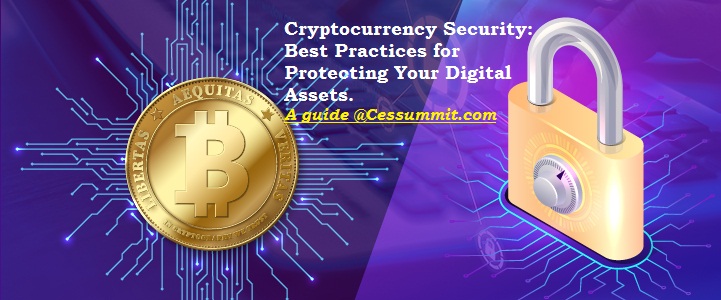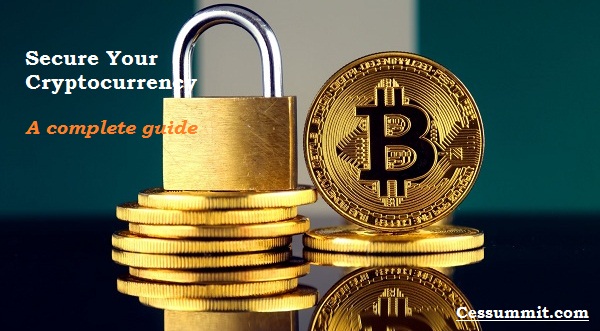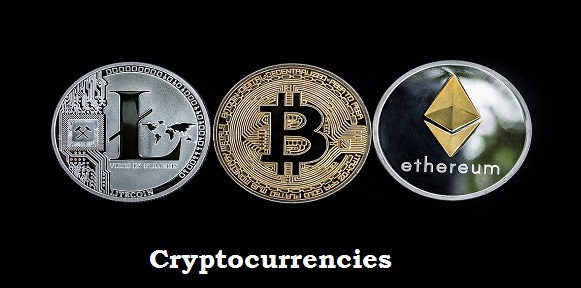
Cryptocurrency Security: Best Practices for Protecting Your Digital Assets
Cryptocurrency Security: Best Practices for Protecting Your Digital Assets – In the rapidly evolving world of cryptocurrency, where digital assets hold immense value, ensuring the security of your investments has become paramount. As the popularity and adoption of cryptocurrencies continue to soar, so does the risk of cyber threats and attacks. Protecting your digital assets requires a proactive approach and adherence to best practices in cryptocurrency security. By implementing robust security measures, employing secure storage solutions, and adopting responsible online behavior, you can safeguard your investments and navigate the exciting yet volatile landscape of cryptocurrencies with confidence.
Contents
- 1 The Post Focus:
- 1.1 Cryptocurrency Security: Best Practices for Protecting Your Digital Assets is a must-read for Asset owners!
- 1.2 Cryptocurrency Security: Best Practices for Protecting Your Digital Assets
- 1.3 Introduction
- 1.4 Choosing a Secure Wallet
- 1.5 Implementing Strong Passwords and Authentication
- 1.6 Keeping Software Up to Date
- 1.7 Cryptocurrency Security: Best Practices for Protecting Your Digital Assets
- 1.8 Beware of Phishing and Social Engineering Attacks
- 1.8.1 Cryptocurrency Security: Best Practices for Protecting Your Digital Assets
- 1.8.2 Cryptocurrency Security: Best Practices for Protecting Your Digital Assets
- 1.8.3 Cryptocurrency Security: Best Practices for Protecting Your Digital Assets
- 1.8.4 Cryptocurrency Security: Best Practices for Protecting Your Digital Assets
- 1.9 Securing Internet Connections
- 1.10 Backup and Recovery Strategies
- 1.11 Diversifying and Monitoring Investments
- 1.12 Cryptocurrency Security: Best Practices for Protecting Your Digital Assets
- 1.13 Avoiding Suspicious Websites and Apps
- 1.13.1 Cryptocurrency Security: Best Practices for Protecting Your Digital Assets
- 1.13.2 Cryptocurrency Security: Best Practices for Protecting Your Digital Assets
- 1.13.3 Being Cautious with Third-Party Services
- 1.13.4 Cryptocurrency Security: Best Practices for Protecting Your Digital Assets
- 1.13.5 Cryptocurrency Security: Best Practices for Protecting Your Digital Assets
- 1.14 Cold Storage and Offline Storage
- 1.15 Conclusion
- 1.16 Cryptocurrency Security: Best Practices for Protecting Your Digital Assets
- 1.17 Read More:
- 1.18 Summing Up: Cryptocurrency Security: Best Practices for Protecting Your Digital Assets
- 1.19 Share this:
- 1.20 Like this:
The Post Focus:
Cryptocurrency Security: Best Practices for Protecting Your Digital Assets is a must-read for Asset owners!
If you’re an asset owner in the world of cryptocurrency, safeguarding your digital assets should be a top priority. The value and potential of cryptocurrencies have attracted the attention of investors worldwide, but with that popularity comes an increased risk of security breaches and theft. To protect your investments, it is crucial to be well-informed and equipped with the best practices in cryptocurrency security.
Whether you’re a seasoned crypto enthusiast or just starting your journey, “Cryptocurrency Security: Best Practices for Protecting Your Digital Assets” is a must-read guide that will empower you with the knowledge and tools to keep your assets safe. By implementing these best practices, you can confidently navigate the dynamic and ever-changing landscape of cryptocurrencies while minimizing the risks associated with storing and managing digital assets.

Cryptocurrency Security: Best Practices for Protecting Your Digital Assets
Introduction
A. Definition of cryptocurrency security
Cryptocurrency security refers to the measures taken to protect digital assets, such as cryptocurrencies like Bitcoin, Ethereum, or any other digital tokens. It involves safeguarding these assets from unauthorized access, theft, fraud, and other malicious activities.
Cryptocurrencies operate on decentralized networks using cryptographic technology, which makes them inherently secure in terms of transaction integrity and immutability. However, securing the digital assets themselves requires additional measures to protect the private keys, wallets, and exchanges used to store and trade cryptocurrencies.
B. Importance of protecting digital assets
Protecting digital assets is crucial for several reasons:
- Asset Preservation: Cryptocurrencies can hold significant value, and losing access to or control over them can result in financial loss. Proper security measures help prevent theft, hacking, or accidental loss of digital assets.
- Personal Privacy: Cryptocurrencies offer the potential for anonymous transactions, and protecting your digital assets ensures your financial privacy. Security measures help prevent unauthorized access to your personal information and transaction history.
- Mitigating Fraud and Scams: The cryptocurrency industry has faced its fair share of scams and fraudulent activities. By implementing robust security measures, individuals and organizations can reduce the risk of falling victim to phishing attacks, Ponzi schemes, and other fraudulent activities prevalent in the crypto space.
- Trust and Adoption: The security of cryptocurrencies plays a vital role in building trust among users and fostering wider adoption. As more individuals and institutions perceive cryptocurrencies as secure and reliable, they are more likely to embrace digital assets and participate in the crypto ecosystem.
- Regulatory Compliance: Governments and regulatory bodies are increasingly focusing on the regulation of cryptocurrencies. Implementing adequate security measures ensures compliance with existing and future regulations, which can help protect users and maintain the integrity of the overall financial system.
In summary, protecting digital assets through robust security measures is essential to safeguarding financial resources, maintaining personal privacy, mitigating fraud, fostering trust, and complying with regulatory requirements.
Cryptocurrency Security: Best Practices for Protecting Your Digital Assets
Choosing a Secure Wallet
A. Types of cryptocurrency wallets (hardware, software, paper)
When selecting a cryptocurrency wallet, you have several options:
- Hardware Wallets: These are physical devices specifically designed to store cryptocurrency securely. They store private keys offline, making them less vulnerable to online threats. Examples include Ledger Nano S, Trezor, and KeepKey.
- Software Wallets: These wallets exist as software applications on computers, smartphones, or tablets. They can be further categorized into:
- Desktop Wallets: Installed on a computer and accessed locally. Examples include Electrum (Bitcoin), Exodus, and Atomic Wallet.
- Mobile Wallets: Installed on a smartphone or tablet, offering convenience and accessibility. Examples include Trust Wallet, Mycelium (Bitcoin), and Jaxx Liberty.
- Web Wallets: Accessed through a web browser, these wallets are convenient but come with additional security risks. Examples include MetaMask, MyEtherWallet (MEW), and Binance Wallet.
- Paper Wallets: A paper wallet involves generating a new set of keys and printing them on paper. It’s a cold storage method and keeps the keys offline. Services like BitAddress or WalletGenerator.net can assist in creating paper wallets.
B. Evaluating wallet security features (encryption, multi-factor authentication)
When assessing wallet security features, consider the following:
- Encryption: Ensure the wallet encrypts your private keys and any other sensitive information. This provides an extra layer of protection in case of unauthorized access.
- Multi-Factor Authentication (MFA): MFA adds an extra step to the authentication process, making it more secure. Look for wallets that offer options like SMS verification, authenticator apps (Google Authenticator, Authy), or hardware keys (YubiKey) for enhanced security.
- Backup and Recovery: Wallets should provide a straightforward process for backing up your wallet’s data or recovering it in case of loss or device failure. This can be in the form of mnemonic phrases, seed phrases, or backup files.
- Open-Source Code: Open-source wallets allow the community to review the code for vulnerabilities, ensuring transparency and reducing the risk of hidden security flaws.
C. Researching reputable wallet providers
Before choosing a wallet provider, it’s crucial to conduct thorough research:
- Reputation: Look for well-established wallet providers with a positive reputation and a track record of security. Read user reviews and seek recommendations from trusted sources.
- Development Team: Investigate the team behind the wallet. Check their experience, expertise, and involvement in the cryptocurrency community. Transparent and active development teams are more likely to address security vulnerabilities promptly.
- Community Support: Evaluate the wallet’s user community. Look for active forums, communities, or social media channels where users discuss their experiences and provide feedback on security and functionality.
- Security Audits: Check if the wallet provider has undergone external security audits or received certifications from reputable security firms. This demonstrates a commitment to security and a proactive approach to identifying and fixing vulnerabilities.
Remember to always download wallets from official sources to avoid counterfeit or malicious versions.
Cryptocurrency Security: Best Practices for Protecting Your Digital Assets
Implementing Strong Passwords and Authentication
A. Creating complex passwords
When creating passwords for wallets and other accounts, follow these best practices:
- Length and Complexity: Use a combination of upper and lowercase letters, numbers, and special characters. Aim for a minimum of 12 characters.
- Avoid Common Phrases: Don’t use easily guessable passwords like “123456” or “password.” Avoid personal information such as names, birthdays, or addresses.
- Unique Passwords: Use a different password for each wallet or account to prevent a single breach from compromising multiple platforms.
Cryptocurrency Security: Best Practices for Protecting Your Digital Assets
B. Using password managers
Consider using a password manager to generate and store complex passwords securely. Password managers like LastPass, Dashlane, or KeePass can generate strong passwords and store them in an encrypted vault. They also offer features like auto-fill, synchronization across devices, and secure password sharing.
C. Enabling two-factor authentication (2FA)
Enable two-factor authentication whenever possible for an additional layer of security. This requires a second verification step, usually through a mobile app or SMS, to access your wallet or account. Most reputable wallet providers offer 2FA as an option.
Cryptocurrency Security: Best Practices for Protecting Your Digital Assets
D. Considering hardware-based authentication methods
For enhanced security, consider hardware-based authentication methods:
- Hardware Security Keys: Devices like YubiKey or Ledger Nano S can provide secure two-factor authentication and protect against phishing attacks. They require physical presence for authentication.
- Biometric Authentication: Some wallets or devices support biometric authentication, such as fingerprint or facial recognition. While convenient, ensure the device’s biometric data is securely stored and not easily exploitable.
By implementing strong passwords, using password managers, enabling two-factor authentication, and considering hardware-based authentication methods, you significantly enhance the security of your cryptocurrency wallets and accounts.
Cryptocurrency Security: Best Practices for Protecting Your Digital Assets
Keeping Software Up to Date
A. Importance of regular updates
Regularly updating your wallet software and any other associated software is crucial for maintaining security. Updates often include bug fixes, performance improvements, and most importantly, patches for any identified vulnerabilities. By staying up to date, you ensure that your wallet software has the latest security measures in place, reducing the risk of exploitation.
B. Understanding software vulnerabilities and patches
Software vulnerabilities are weaknesses or flaws that can be exploited by attackers to gain unauthorized access or control over a system. Developers constantly monitor and identify vulnerabilities in their software. When a vulnerability is discovered, they release patches or updates to fix the issue and improve security.
Patching your wallet software involves applying these updates to address any known vulnerabilities and enhance security. Failure to update leaves your wallet susceptible to known attack vectors.
Cryptocurrency Security: Best Practices for Protecting Your Digital Assets
C. Automatic update options
Many wallet providers offer automatic update options to simplify the process and ensure you stay up to date with the latest security patches. Enabling automatic updates allows your wallet software to download and install updates automatically, reducing the risk of oversight or delay in applying important security fixes.
However, it’s also important to note that automatic updates may have associated risks, such as compatibility issues or unexpected changes in functionality. Therefore, it’s advisable to regularly review release notes or update notifications to understand the changes being made and ensure they align with your needs.

Cryptocurrency Security: Best Practices for Protecting Your Digital Assets
Beware of Phishing and Social Engineering Attacks
A. Recognizing phishing attempts
Phishing is a common method used by attackers to trick individuals into revealing sensitive information, such as passwords or private keys. Be vigilant and look out for the following signs of a phishing attempt:
- Suspicious Emails: Be cautious of emails requesting urgent action, such as clicking on links, providing personal information, or downloading attachments. Check for misspellings, grammatical errors, or email addresses that don’t match the official domain.
- Fake Websites: Phishing websites may imitate the design and layout of legitimate wallets or exchanges. Always double-check the website’s URL for any variations or inconsistencies.
Cryptocurrency Security: Best Practices for Protecting Your Digital Assets
B. Verifying website authenticity
To verify the authenticity of a website:
- Bookmark Official Websites: Save the official website URLs of your wallet providers or exchanges and use these bookmarks to access their services. Avoid relying on search engine results, as they may lead you to fraudulent websites.
- Check SSL Certificates: Look for the padlock symbol in the website’s URL bar, indicating a secure connection. Click on the padlock to view the SSL certificate information. Ensure the certificate is issued to the correct entity.
C. Avoiding suspicious links and email attachments
Exercise caution when encountering links or attachments in emails, social media messages, or other communications:
- Hover over Links: Hover your mouse cursor over a link to view the actual URL it points to. Be cautious if the URL seems unrelated to the context or leads to a suspicious website.
- Don’t Download Untrusted Attachments: Avoid downloading and opening attachments from unknown or untrusted sources, as they may contain malware or phishing attempts.
Cryptocurrency Security: Best Practices for Protecting Your Digital Assets
D. Educating oneself and staying vigilant
Staying educated and vigilant is crucial to protect yourself from phishing and social engineering attacks:
- Stay Informed: Keep up with the latest news and security alerts related to cryptocurrencies and wallet security. Subscribe to reliable sources, follow security blogs, and participate in relevant online communities.
- Be Skeptical: Exercise a healthy level of skepticism when receiving unsolicited messages or encountering suspicious situations. Think twice before sharing sensitive information or taking immediate action.
- Verify Information: If you receive communication requesting personal information or sensitive data, independently verify the request through official channels, such as the official website or customer support.
Cryptocurrency Security: Best Practices for Protecting Your Digital Assets
By being aware of phishing techniques, verifying website authenticity, avoiding suspicious links and attachments, and staying educated and vigilant, you can significantly reduce the risk of falling victim to phishing and social engineering attacks.
Remember, it’s essential to remain cautious and skeptical even when dealing with seemingly legitimate requests or communications. Attackers can be sophisticated and employ tactics to make their attempts appear genuine. Taking the time to verify the information and practicing good security hygiene will help protect your cryptocurrency assets.
Overall, maintaining awareness, staying up to date with the latest security practices, and exercising caution when interacting online is vital for safeguarding your digital assets from phishing and social engineering attacks.
Cryptocurrency Security: Best Practices for Protecting Your Digital Assets
Securing Internet Connections
A. Using secure Wi-Fi networks
When conducting cryptocurrency transactions or accessing your wallet online, it’s crucial to use secure Wi-Fi networks:
- Home Network: Ensure your home Wi-Fi network is password-protected and uses encryption protocols like WPA2 or WPA3. Regularly update your router firmware to address any security vulnerabilities.
- Secure Hotspots: If you need to use public Wi-Fi, connect only to trusted and secure hotspots. Verify the network name and seek recommendations from reliable sources.
B. Avoiding public Wi-Fi for cryptocurrency transactions
It’s generally advisable to avoid conducting cryptocurrency transactions or accessing your wallet using public Wi-Fi networks, such as those found in cafes, airports, or other public spaces. Public Wi-Fi networks are often unsecured and can be compromised by attackers, allowing them to intercept sensitive data.
Cryptocurrency Security: Best Practices for Protecting Your Digital Assets
C. Utilizing virtual private networks (VPNs) for added security
Using a virtual private network (VPN) adds an extra layer of security when accessing the internet, including cryptocurrency-related activities. VPNs encrypt your internet traffic and route it through a secure server, protecting your data from potential eavesdropping or interception.
When using a VPN, choose a reputable provider and connect to servers located in trusted jurisdictions. This helps maintain the privacy and integrity of your online activities, including cryptocurrency transactions.
Cryptocurrency Security: Best Practices for Protecting Your Digital Assets
Backup and Recovery Strategies
A. Regularly backing up wallet data
Regularly backing up your wallet data is crucial to prevent data loss in case of device failure, accidental deletion, or other unforeseen circumstances. Wallets usually provide options to create backups, such as mnemonic phrases, seed phrases, or backup files.
Set a schedule to back up your wallet data at regular intervals, especially after significant changes or transactions.
Cryptocurrency Security: Best Practices for Protecting Your Digital Assets
B. Storing backups in secure locations (offline, encrypted)
Ensure you store your backups in secure locations:
- Offline Storage: Consider storing backups on offline devices, such as external hard drives or USB drives, which are disconnected from the internet when not in use. This protects against online threats.
- Encrypted Storage: Encrypt your backup files before storing them. This adds an extra layer of security and ensures that even if the backup falls into the wrong hands, the data remains inaccessible without the encryption key.
C. Testing recovery processes
Regularly test the recovery process for your wallet to ensure you can successfully restore your wallet using the backups. Verify that you can access your funds and perform transactions after restoration. This practice helps identify any issues or errors in the backup and recovery process before you need to rely on it.
Cryptocurrency Security: Best Practices for Protecting Your Digital Assets
Diversifying and Monitoring Investments
A. Spreading investments across different cryptocurrencies
Diversifying your cryptocurrency investments helps mitigate risk and reduces exposure to any single digital asset. Consider investing in multiple cryptocurrencies with varying market dynamics and use cases. This strategy can help balance potential gains and losses.
B. Tracking portfolio performance
Regularly monitor and track the performance of your cryptocurrency portfolio using reliable tracking tools and platforms. This allows you to stay informed about the value of your investments, identify trends, and make informed decisions based on market conditions.
Cryptocurrency Security: Best Practices for Protecting Your Digital Assets
C. Monitoring news and market trends
Stay updated with cryptocurrency news and market trends to understand the broader landscape and potential impact on your investments. News about regulatory developments, security incidents, or technological advancements can significantly influence cryptocurrency prices and market sentiment.
Consider subscribing to reputable cryptocurrency news sources, following industry influencers, and joining online communities to stay informed about important developments in the crypto space.
By securing your internet connections, implementing backup and recovery strategies, and diversifying and monitoring your investments, you can enhance the overall security and resilience of your cryptocurrency holdings.

Cryptocurrency Security: Best Practices for Protecting Your Digital Assets
Avoiding Suspicious Websites and Apps
A. Verifying website and app authenticity
When accessing websites or downloading apps related to cryptocurrencies, take the following precautions:
- Check URLs: Verify that the website address (URL) matches the official website of the service or platform you intend to use. Be cautious of slight variations or misspellings that could indicate a fraudulent website.
- App Store Verification: When downloading cryptocurrency-related apps, use official app stores (such as Google Play Store or Apple App Store) to reduce the risk of downloading malicious or counterfeit apps. Check the developer name and read reviews before downloading.
Cryptocurrency Security: Best Practices for Protecting Your Digital Assets
B. Reading user reviews and ratings
Before using a new website or app related to cryptocurrencies, read user reviews and ratings to gain insights into others’ experiences. This can help identify potential issues or red flags related to security, functionality, or customer support. Consider both positive and negative reviews to get a balanced perspective.
C. Using official sources for downloads and updates
To minimize the risk of downloading compromised or malicious software, always use official sources for downloading wallets, apps, or software updates. Visit the official website of the wallet provider or developer to ensure you are accessing legitimate and up-to-date software.
Avoid downloading wallets or software from untrusted sources, as they may contain malware or be modified versions with malicious intent.
Cryptocurrency Security: Best Practices for Protecting Your Digital Assets
Being Cautious with Third-Party Services
A. Assessing the reputation and security measures of third-party services
When using third-party services in the cryptocurrency ecosystem, such as exchanges, trading platforms, or portfolio trackers, consider the following:
- Reputation: Research the reputation of the service provider. Look for reviews, feedback, and discussions from other users to gauge their trustworthiness and reliability.
- Security Measures: Check if the service provider has implemented robust security measures, such as encryption, two-factor authentication, and cold storage for funds. Look for evidence of regular security audits or certifications.
B. Limiting exposure of private keys and sensitive information
Exercise caution when providing private keys, API keys, or other sensitive information to third-party services. Only share this information with trusted services that require it for specific purposes, such as wallet integration or API access. Avoid unnecessarily exposing private keys or sensitive data to minimize the risk of unauthorized access or misuse.
Cryptocurrency Security: Best Practices for Protecting Your Digital Assets
C. Regularly reviewing and auditing third-party services
Periodically review and audit the third-party services you use. Stay informed about any security incidents, breaches, or reports of suspicious activity related to the services. If any concerns arise, consider reevaluating your use of the service and taking appropriate actions, such as withdrawing funds or discontinuing use.
Regularly assessing and reviewing third-party services helps ensure that you are using reputable and secure platforms that align with your risk tolerance and security requirements.
By being cautious with suspicious websites and apps, conducting due diligence on third-party services, and limiting the exposure of sensitive information, you can minimize the risks associated with fraudulent or compromised services in the cryptocurrency ecosystem.
Cryptocurrency Security: Best Practices for Protecting Your Digital Assets
Cold Storage and Offline Storage
A. Understanding cold storage and offline wallet options
Cold storage refers to the practice of keeping cryptocurrency private keys offline, away from internet-connected devices, to minimize the risk of unauthorized access or hacking. Offline wallets are commonly used for cold storage and can be categorized as follows:
- Paper Wallets: A paper wallet involves generating a cryptocurrency address and private key offline, usually through a trusted generator. The keys are printed or written down on paper and stored securely.
- Hardware Wallets: Hardware wallets are physical devices designed specifically for securely storing cryptocurrency private keys. They keep the keys offline and provide a user-friendly interface for securely managing transactions.
B. Evaluating the pros and cons of different storage methods
Consider the following pros and cons when choosing between different storage methods:
- Online Wallets (Hot Wallets): Pros: Convenient for frequent transactions, accessible from multiple devices. Cons: More vulnerable to hacking, and potential loss of funds due to security breaches.
- Cold Storage (Offline Wallets): Pros: Significantly reduces the risk of hacking and online threats, increased control over private keys. Cons: Less convenient for frequent transactions, potential risk of physical damage or loss if not stored properly.
Cryptocurrency Security: Best Practices for Protecting Your Digital Assets
C. Using hardware wallets for enhanced security
Hardware wallets offer a high level of security for storing cryptocurrency. They provide an offline, tamper-resistant environment for generating and storing private keys, ensuring that the keys never leave the device. Hardware wallets also often incorporate additional security features, such as built-in screens and buttons for verifying transactions.
By using a hardware wallet, you can enhance the security of your cryptocurrency by keeping your private keys offline and protected from potential online threats.
Cryptocurrency Security: Best Practices for Protecting Your Digital Assets
Conclusion
In conclusion, securing your cryptocurrency assets requires a proactive approach and adherence to best practices. By implementing the following key measures, you can enhance the security of your digital assets:
- Choose a secure wallet and evaluate its security features.
- Implement strong passwords and two-factor authentication.
- Keep your software up to date to patch vulnerabilities.
- Stay vigilant against phishing and social engineering attacks.
- Secure your internet connections and consider using VPNs.
- Regularly back up wallet data and test recovery processes.
- Diversify and monitor your investments while staying informed.
- Exercise caution with suspicious websites, apps, and third-party services.
- Consider cold storage and hardware wallets for added security.
Remember, cryptocurrency security is an ongoing process that requires ongoing vigilance and education. Stay informed about the latest security practices, news, and potential threats in the cryptocurrency space. By taking these precautions and maintaining a proactive mindset, you can significantly reduce the risk of security breaches and protect your cryptocurrency investments.

Cryptocurrency Security: Best Practices for Protecting Your Digital Assets
Read More:
- The Potential Benefits of Adopting E-Naira in Business Operations
- The Role of E-Naira in Fostering Financial Inclusion for Business Owners
- E-Naira and Digital Marketing in Nigeria
- How to Harness The Power of E-Naira for Cashless Payments in Business
- How E-Naira Will Promote Tax Compliance In Nigeria
- How to Write Winning Proposals that Close Deals
- How to Raise Funds for Your Project by Crowdfunding
- Cessummit.com Services Offerings: What we do & How
- Profitable Business Idea
Summing Up: Cryptocurrency Security: Best Practices for Protecting Your Digital Assets
In this comprehensive guide to cryptocurrency security, we covered various aspects of protecting your digital assets. We began by defining cryptocurrency security and emphasizing the importance of safeguarding your investments.
We discussed the different types of cryptocurrency wallets, including hardware, software, and paper wallets, and highlighted the significance of evaluating their security features. We emphasized the need for encryption, multi-factor authentication, and researching reputable wallet providers.
Cryptocurrency Security: Best Practices for Protecting Your Digital Assets
Next, we explored the importance of creating strong passwords, using password managers, enabling two-factor authentication (2FA), and considering hardware-based authentication methods. These measures enhance the security of your accounts and prevent unauthorized access.
We emphasized the significance of keeping your software up to date to address vulnerabilities and discussed the importance of understanding software vulnerabilities and patches. We also highlighted the benefits of enabling automatic updates to ensure you have the latest security enhancements.
Phishing and social engineering attacks were addressed in detail, focusing on recognizing and avoiding suspicious emails, links, and attachments. We emphasized the need to verify website authenticity and stay educated to protect against these deceptive tactics.
Cryptocurrency Security: Best Practices for Protecting Your Digital Assets
Securing internet connections involved using secure Wi-Fi networks, avoiding public Wi-Fi for cryptocurrency transactions, and utilizing virtual private networks (VPNs) for added security. These practices help protect your data and transactions from potential threats.
We then explored backup and recovery strategies, including the regular backing up of wallet data, storing backups in secure locations, and testing recovery processes. This ensures you can restore your wallet and access your funds in case of unforeseen circumstances.
Diversifying and monitoring investments were highlighted as essential practices to reduce risk and stay informed about the performance of your portfolio. We emphasized the importance of spreading investments across different cryptocurrencies, tracking portfolio performance, and monitoring news and market trends.
Cryptocurrency Security: Best Practices for Protecting Your Digital Assets
To mitigate risks, we discussed the importance of avoiding suspicious websites and apps by verifying their authenticity, reading user reviews, and using official sources for downloads and updates. We also emphasized the need to exercise caution when using third-party services, assess their reputation and security measures, and regularly review and audit them.
Lastly, we covered the concepts of cold storage and offline storage, explaining their benefits and different options such as paper wallets and hardware wallets. We highlighted the enhanced security provided by hardware wallets for storing cryptocurrency offline.
In conclusion, securing your cryptocurrency assets requires a combination of knowledge, best practices, and ongoing vigilance. By following the recommendations outlined in this guide, you can significantly enhance the security of your digital assets and protect yourself from potential threats in the dynamic cryptocurrency landscape.






